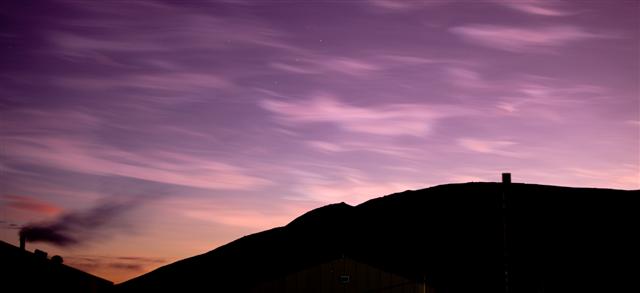Winfly 2009NSF plans five flights to prepare McMurdo for 2009-10 summer field seasonPosted August 21, 2009
On the north side of the equator, August usually means the kids are heading back to school, the days are growing shorter and the Chicago Cubs are once again planning ways to self-destruct en route to the World Series. Winfly in Photos
For more images of the first Winfly flight by electrician Chad Carpenter, check out this page.
On the flip side of the equator, where the seasons flop in the opposite direction, the sun is returning and Antarctica is coming out of six months of winter hibernation. Game on for the U.S. Antarctic Program (USAP) The first flight since February was scheduled to land at McMurdo Station 
Photo Credit: Ken Klassy/Antarctic Photo Library
Nacreous clouds near McMurdo Station last month. The clouds only appear in the polar regions, in the stratosphere, when temperatures are below minus 100 degrees Fahrenheit.
The U.S. Air Force will eventually make five roundtrips between Christchurch, New Zealand, and McMurdo to carry people and supplies to the continent to prepare the research station for the beginning of the 2009-10 summer field season, which starts in late September. One flight by the Air Force’s C-17 Globemaster III will be a training mission using night-vision goggles. A U.S. Air Force crew out of McChord Air Force Base The first passenger flight had been scheduled to arrive in McMurdo one day after the first official sunrise of the year. Eventually, as the short southern spring gives way to summer, the sun will remain above the horizon for 24 hours until next April. About 350 people will make the trip south for Winfly, including about two dozen scientists, a large contingent for that time of the year, as most researchers don’t arrive until the main field season begins. Winfly Science Projects
In The Antarctic Sun:
Snowball Earth SCINI in the Sound Pulse on polynyas From the NSF: Measurements of Antarctic ozone Hunting in Darkness: Weddell seals The Winfly research projects range from studies of the ozone hole, which starts to form in August, to work on understanding the unique physiology of Weddell seals, a project conducted from sea ice that is only stable until November. The 153 winter-over personnel at McMurdo have been busy prepping for the arrival of the fresh workforce, which includes everyone from cooks and mechanics to truck drivers and firefighters. The station population will swell to about a thousand at the height of the five-month field season. The first flight for the summer is scheduled for Sept. 29, with the last flight out currently set for Feb. 19, 2010. |



For USAP Participants |
For The Public |
For Researchers and EducatorsContact UsU.S. National Science FoundationOffice of Polar Programs Geosciences Directorate 2415 Eisenhower Avenue, Suite W7100 Alexandria, VA 22314 Sign up for the NSF Office of Polar Programs newsletter and events. Feedback Form |


